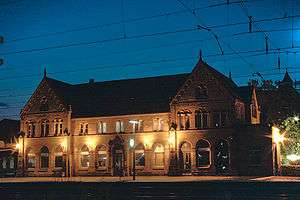Gelnhausen station
Gelnhausen station is the station of the town of Gelnhausen on the Kinzig Valley Railway in the German state of Hesse.
| Through station | ||||||||||||||||||||||||||
 Station building at night | ||||||||||||||||||||||||||
| Location | Bahnhofstraße 6, Gelnhausen, Hesse Germany | |||||||||||||||||||||||||
| Coordinates | 50°11′48″N 9°11′22″E | |||||||||||||||||||||||||
| Line(s) |
| |||||||||||||||||||||||||
| Platforms | 4 | |||||||||||||||||||||||||
| Construction | ||||||||||||||||||||||||||
| Architect | Paul Rowald | |||||||||||||||||||||||||
| Architectural style | Romanesque Revival | |||||||||||||||||||||||||
| Other information | ||||||||||||||||||||||||||
| Station code | 2051[1] | |||||||||||||||||||||||||
| DS100 code | FGEL[2] | |||||||||||||||||||||||||
| IBNR | 8000117 | |||||||||||||||||||||||||
| Category | 4[1] | |||||||||||||||||||||||||
| Website | www.bahnhof.de | |||||||||||||||||||||||||
| History | ||||||||||||||||||||||||||
| Opened | 1 May 1867 | |||||||||||||||||||||||||
| Traffic | ||||||||||||||||||||||||||
| Passengers | 5,000 [3] | |||||||||||||||||||||||||
| Services | ||||||||||||||||||||||||||
| ||||||||||||||||||||||||||
History
The station was built by the Frankfurt–Bebra railway as the station of the former county town of the district of Gelnhausen. Services commenced on the Hanau Ost–Wächtersbach section on 1 May 1867.
Buildings
The station building and the rest of the station buildings are now mostly classified as cultural monuments under the Hessian Monument Protection Act.
Entrance building
The entrance building was built in a Romanesque Revival style of Buntsandstein (coloured sandstone) and so added to the historic buildings of the Hohenstaufen town of Gelnhausen, which include the most famous Romanesque building in the city, the Gelnhausen Palace (Pfalz Gelnhausen), but also the Romanesque House (Romanisches Haus). The architect Paul Rowald also designed Bad Hersfeld station with the same layout and both buildings are built in the same style.
The building was built in 1882/83 and is therefore a structure of the "second generation" of structural engineering on the line. The station building is symmetrically designed on an H-shaped floor plan. On the street side the facade is dominated by three pointed gables, the middle gable is omitted from the design of the facade on the track side. A "princely pavilion" (Fürstenpavillon) was built to the west of the main building with three bay windows; there is also a detached toilet block built in the Romanesque Revival style east of the main building.
Other buildings
The buildings in the station area are the house of the track supervisor (Bahnmeister) from 1868 (a building of the "first generation" of structural engineering on the line), a freight-handling facility from the period around 1870 and a water tower—architecturally out of harmony with the towers of the Gelnhausen town wall—from 1937.
Operations
The station has a home platform (a single-sided outer platform next to the station building) and a two-sided island platform. At the western end of the home platform, there is a bay platform, where services on the Lahn-Kinzig Railway to and from Büdingen and Gießen start and end. The other three platform tracks can be used only by trains on the Kinzig Valley line, which can run from here to Hanau-Wolfgang at 200 km/h. Local trains are often held at Gelnhausen station so that Intercity-Express and Intercity trains can pass them. Gelnhausen station is now only used by local and regional services and has great importance for commuter traffic from the Vogelsberg and Spessart hills of the Rhine-Main region.
Previously two more lines operated to Gelnhausen station:
- The standard gauge Freigericht Light Railway of the Gelnhäusen District Railway started here from 1904 until 1963.
- The narrow gauge Spessart Railway also began here and operated from 1895 to 1951.
The railway facilities of both trains were immediately south of Gelnhausen "state station”. From 1930, both railways had a common platform, which was connected by an underground passage to the platforms of the state railway. The infrastructure for the lines at the station has been demolished and has been replaced by parking lots.
Notes
- "Stationspreisliste 2020" [Station price list 2020] (PDF) (in German). DB Station&Service. 4 November 2019. Retrieved 15 November 2019.
- Eisenbahnatlas Deutschland (German railway atlas) (2009/2010 ed.). Schweers + Wall. 2009. ISBN 978-3-89494-139-0.
- "Ein ort zum Schaudern". Frankfurter Rundschau (in German). Retrieved 2 December 2011.
References
- Landesamt für Denkmalpflege Hessen, ed. (2005). Eisenbahn in Hessen. Kulturdenkmäler in Hessen. Denkmaltopographie Bundesrepublik Deutschland (in German). 2.1. Stuttgart: Theiss Verlag. pp. 336f. ISBN 3-8062-1917-6.
- Eisenbahnatlas Deutschland (German railway atlas) (2009/2010 ed.). Schweers + Wall. 2009. ISBN 978-3-89494-139-0.